Types of Ground Beetles (With Pictures) – Identification Guide
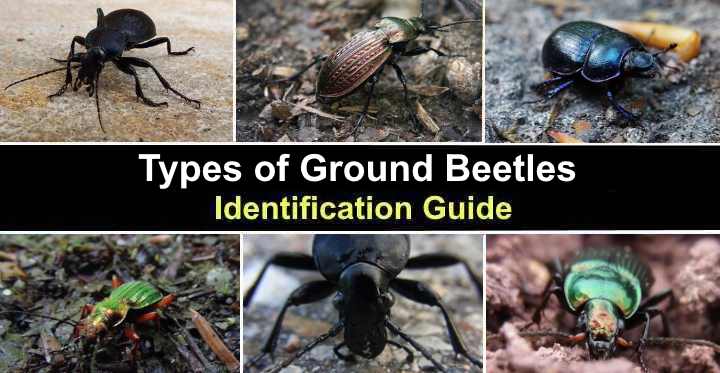
Ground beetles are small insects with relatively long legs and powerful pinchers. Many species of ground beetles are beneficial insects because they feed on common crop and plant pests. However, ground beetles can also become a nuisance in homes during summer and early fall. They enter homes through cracks in doors, foundations, and windows. Although not dangerous, some varieties of ground beetles can bite with their powerful jaws (mandibles).
Identifying ground beetles in the home is crucial to knowing what kind of pest you are dealing with. Some species of these small black or brown beetles can resemble pests like cockroaches, wood boring beetles, carpet beetles, or other invasive insects. Therefore, getting rid of ground beetles involves identifying the species and taking appropriate control measures.
Most ground beetles are small, black insects with flattened oval bodies. However, you can also find brown ground beetles and species of ground beetles with iridescent colors or tan or orange patterns on their hard shells.
This article is an identification guide for the most common ground beetles you will likely find in your yard or home. In addition to descriptions, pictures of ground beetles will help you tell the difference between these insects and other pests in your home. Finally, at the end of the article, you’ll get helpful tips on getting rid of ground beetles.
How to Identify Ground Beetles
Ground beetles are identified by their shiny, oval black, brown, or sometimes metallic flattened bodies. Most species of ground beetles measure 0.125” to 0.5” (3 – 12 mm) long. A characteristic feature is that their heads are narrower than their neck. In addition, ground beetles have strong pincer-like mandibles, six legs, and two long antennae.
Ground beetles belong to the insect family Carabidae. Commonly called carabids, the small dark-bodied insects have wings, but most never fly and just scurry along the ground.
The life cycle of a ground beetle starts as an egg before the larva hatches and then pupates underground. Typically, only adult ground beetles are seen above ground. You will find them crawling on the ground. Carabid beetles are usually found under rocks, stones, logs, and grassy areas when resting.
Are Ground Beetles Dangerous?
Ground beetles are harmless creatures and are more of a nuisance in the home. The small brown and black beetles don’t damage clothing, wooden structures, or food. The main irritation ground beetles cause is the malodorous defensive secretions they emit when threatened. They also may pinch your skin with their mandibles.
For example, black ground beetles in the home can hide in foodstuffs and spoil the flavor.
In general, ground beetles are considered beneficial insects. Many species of ground beetles feed on other insect larvae, small insects, aphids, mites, slugs, snails, and other invertebrates. Additionally, they also feed on many plants considered to be weeds.
Ground beetles damage plants and crops only when their numbers are particularly large. In that case, it’s a good idea to have control measures to eliminate as many ground beetles as possible.
Types of Ground Beetles (Pictures, Identification, and Control)
There are over 2,000 species of ground beetles found in North America. Most ground beetles are relatively small black insects under 0.5” (12 mm) long. However, the enormous murky ground beetle (Harpalus caliginosus) is 1” (25 mm). Common species of ground beetles include Pedunculate (Scarites spp.), Brachininae spp., and Pennsylvania ground beetles (Harpalus spp.).
Let’s look in more detail at identifying features of common ground beetles.
Pedunculate Ground Beetles (Scarites spp.)
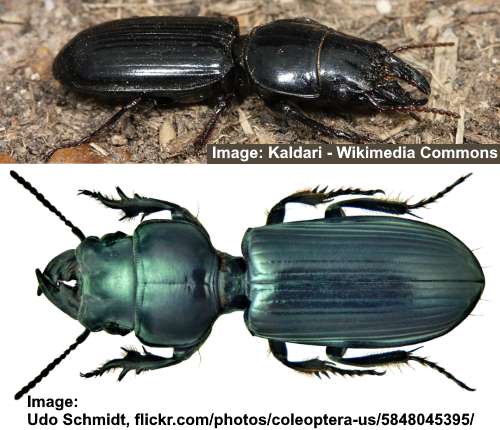
Pedunculate ground beetles (Scarites spp.). Top picture: Scarites subterraneus (big-headed ground beetle). Bottom: Scarites linearis
Pedunculate ground beetles are large predatory insects with shiny black bodies and large prominent pincers. An identifying feature of beetles in the genus Scarites is their oval abdomen that has a straight edge at its narrow waist. In addition, this glossy black beetle has a broad head with two marginal depressions.
Pedunculate beetles are relatively large compared to other carabids. These black beetles with pincers measure 0.55” to 1.18” (14 – 30 mm) long. A skinny waist, ridged wing covers (elytra), and large mandibles make it easy to identify pedunculate ground beetles.
Due to their color and distinctive large pincers, it’s easy to confuse pedunculate ground beetles for stag beetles. However, the distinguishing feature is the noticeable thin waist of ground beetles in the Scarites genus.
Like other varieties of ground beetles, pedunculate ground beetles are usually found scurrying through grass, in open fields, along woodland floors, gardens, and other places, searching for insects, caterpillars, and bugs. They use their large pincers and mandibles to catch and devour prey.
You will also find the large black ground beetles hiding under mulch, leaf litter, logs, and stones. The ground beetles also burrow into the ground. The black beetles are active during spring and summer and can typically be a nuisance in homes during August. They are nocturnal hunters.
A unique aspect of this carabid genus is its excellent ability to act. If approached too close, pedunculate ground beetles have an unusual defensive mechanism. When threatened, the black insect will lay flat on its back and pretend to be dead.
Researchers say this black ground beetle is not dangerous or harmful to humans or property.
Pennsylvania Ground Beetles (Harpalus spp.)
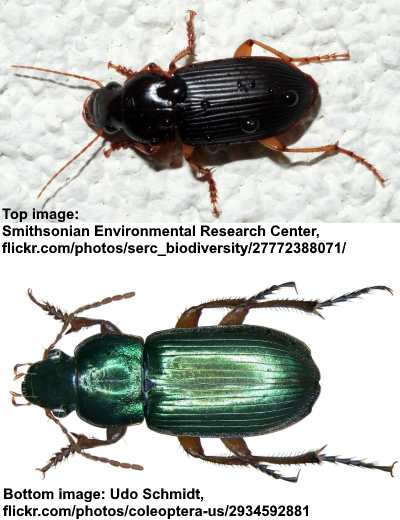
Top image: Pennsylvania ground beetle (Harpalus pensylvanicus). Bottom: Harpalus affinis
Pennsylvania ground beetles are common native North American insect species with small black oval bodies, short brownish legs, and mandibles. These carabid beetles have a shiny black head and ribbed elytra. However, the underside of these ground beetles is reddish brown. Pennsylvania ground beetles measure 0.51” to 0.63” (13 – 16 mm).
Pennsylvania ground beetles are most active during August and September. The shiny black beetles typically feed on plant and weed seeds. Scientists say that the beetles consume redroot pigweed, giant foxtail, lambsquarters, green bristle grass, and cupgrass. In addition, these beneficial beetles can also help control cucumber beetles, aphids, zebra caterpillars, and corn borers.
Although Pennsylvania ground beetles are regarded as beneficial insects, they can damage some plants. For example, they are known to attack ripening strawberries and other soft fruit that grow on the ground.
There are over 400 Harpalus beetles, with the Pennsylvania ground beetle (Harpalus pensylvanicus) being the most common in North America. Many of the individual species have similar characteristics — a shiny black oval body, thin head, and brownish antennae, mandibles, and legs.
One eye-catching Harpalus beetle is the Harpalus affinis. This small beetle has a metallic green shiny body, dark tan legs, and antennae. However, depending on the light, the ground beetle could appear black, blue, or metallic bronze. Although not native to North America, it has been introduced and is found in several states.
Pterostichus Ground Beetles (Pterostichus spp.)
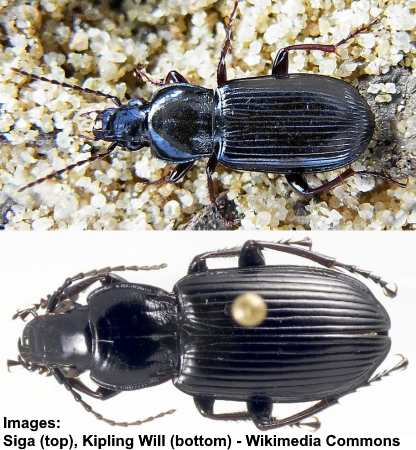
Top image: Pterostichus anthracinus. Bottom: Pterostichus melanarius (rain beetle)
Pterostichus ground beetles are common black beetles characterized by a dull black body, ribbed elytra, and two filiform antennae. These widely-distributed ground beetles are large, with species measuring between 0.59” and 0.82” (15 – 21 mm). Like many ground beetle species, this black insect has a thin head, rounded pronotum (the plate over the thorax), and an oval body.
One of the most common black beetles in the genus Pterostichus is the rain beetle (Pterostichus melanarius). This black beetle is a non-descript black color with ridged lines down its wing cover. Other common black carabid beetles like Pterostichus have a glossier black sheen. However, other more exotic beetles in this genus have a shiny metallic luster.
There are over 1,100 species of Pterostichus ground beetles, and they are the most common type of ground-dwelling beetle in North America. You will find the medium- to large-sized beetles in fields, meadows, grasslands, woodlands, and urban areas. Unfortunately, the beetles can become a pesky nuisance in homes in late summer and fall and are typically active during nighttime.
Bembidion Ground Beetles (Bembidion spp.)
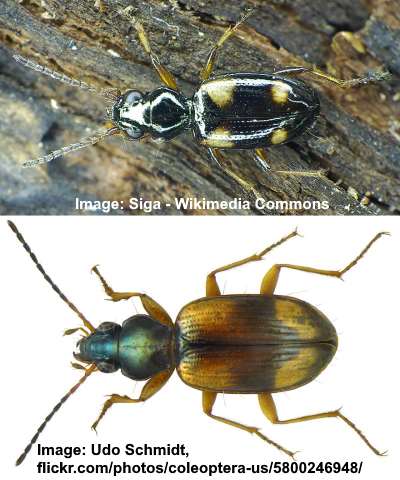
Top picture: Bembidion quadrimaculatum. Bottom: Bembidion tetracolum
Bembidion ground beetles comprise one of the largest genera of ground beetles. However, they are also some of the smallest ground beetles. There is also a wide variation in coloration between individual species. Bembidion beetles typically measure less than 0.29” (7.5 mm) long. They also have a distinct shape, with a thin waist between the thorax and a flat edge of the abdomen.
Some species of these ground beetles, like the Bembidion tetracolum, have characteristic mottled black and brown patterns on their wing covers. In addition, some small Bembidion ground beetles have shiny black bodies with creamy yellow patches.
Notable features of these tiny ground beetles are their tremendous speed, ability to fly, and usefulness for feeding on pest larvae. They use these behavioral instincts to escape from predators. However, due to their size, they also become prey for larger ground beetles and spiders.
Bombardier Ground Beetles (Brachininae spp.)
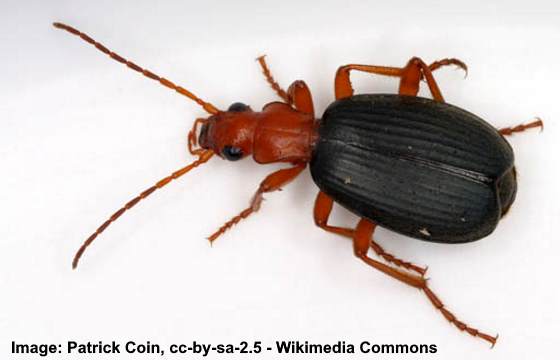
Bombardier beetle (Brachininae spp.)
Bombardier ground beetles are a subfamily of beetles, many of which have distinctive brown and black coloring. The colorful carabid beetles typically have a thin head and thorax in relation to the oval, flattened coffee bean-shaped body. In addition, many individual species have mat-black elytra, orange-brown or rusty brown legs, heads, and antennae.
Black and brown bombardier ground beetles are typically small, measuring 0.17” to 0.37” (4.5 – 9.5 mm) long. Like most species of nocturnal ground beetles, these tiny creatures are found in grasslands, under rocks, loose boards, and woodland floors. However, you will most likely find these beetles in wet or damp environments, like in bogs and the edges of ponds or streams.
There are over 500 species of bombardier ground beetles. However, they all have one distinctive habit in common. The flying beetles emit a hot, stinging, corrosive spray to defend themselves. This is how they get their common name, bombardier beetle.
False Bombardier Beetle (Galerita bicolor)
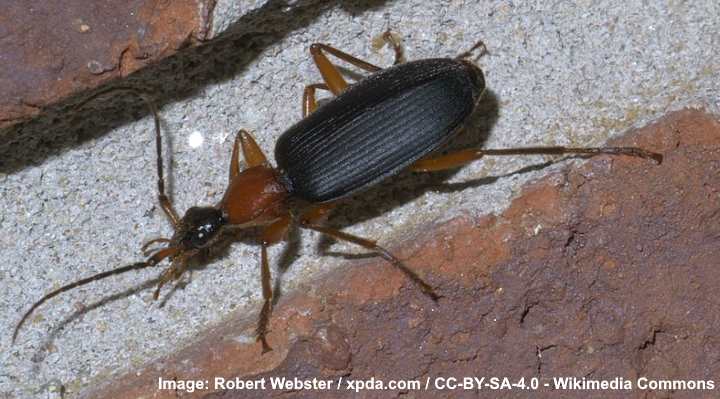
False bombardier beetle (Galerita bicolor)
The false bombardier beetle is a species of orange-brown and black ground beetle that looks like several species of true bombardier beetles. These large ground-dwelling beetles have a recognizable black oval abdomen, rusty brown thorax, and small black heads. Although this species looks like a bombardier beetle, it’s much larger.
The false bombardier beetle is a large ground beetle measuring 0.68” to 0.88” (17.5 – 22.5 mm). These black and orange ground beetles are common throughout the eastern United States. They mainly feed on small insects and don’t cause plant damage.
Caterpillar Hunter Beetles (Calosoma spp.)
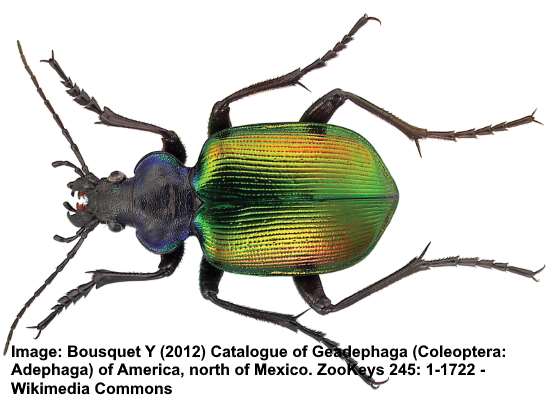
The forest caterpillar hunter (Calosoma sycophanta)
Caterpillar hunter beetles belong to a large group of ground beetles, identified by their bright metallic green bodies. The large shiny green beetles with their iridescent shades can appear bronze, copper, blue, green, and gold black. Most species in the genus Calosoma have black or bright blue heads.
These large, stout green beetles have a broad body, black head, and prominent black pincers. The green ground beetles grow between 1” and 1.37” (25 – 35 mm), depending on the species.
As their common name suggests, these sizable ground beetles feed on caterpillars, making them perfect for controlling various species of moth or butterfly larvae. According to some studies, species like the Calosoma sycophanta can consume up to 50 caterpillars in two weeks.
Although these shiny green ground beetles are native to Europe, they were introduced to North America to control gypsy moth caterpillars
Lebia grandis
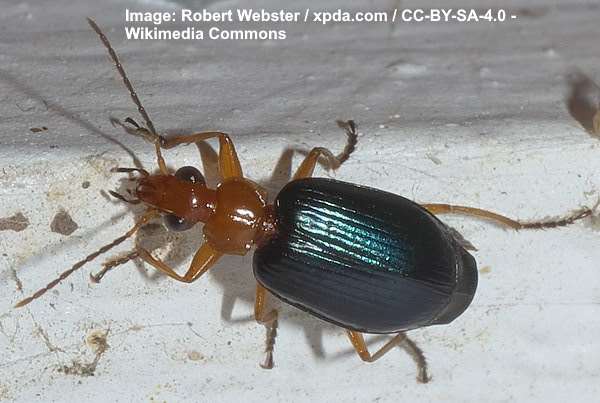
Lebia grandis
Lebia grandis is a beneficial ground beetle with a broad black oval body with blue-green iridescent undertone, an orange head, and a distinctive orange band at the base of its wing covers. An identifying feature of the ground beetle is its two prominent black eyes on a small orange head.
Lebia grandis belongs to the genus of predatory ground beetles Lebia, of which there are hundreds of species. They are also called flat ground beetles or colorful foliage ground beetles. Most species have spectacular vivid coloring or iridescent patterns on their flattened elytra. Beetles in the genus Lebia measure 0.09” to 0.55” (2.5 – 14 mm).
Lebia grandis is the largest species in the genus. It measures 0.33” to 0.41” (8.5 – 10.5 mm) long. The black or iridescent blue beetle with its rusty orange head is a valuable control insect for Colorado potato beetles (Leptinotarsa decemlineata). The Lebia grandis emerges after Colorado potato beetles have laid eggs. And they can eat up to 23 beetle eggs per day.
Carabus Ground Beetles (Carabus spp.)
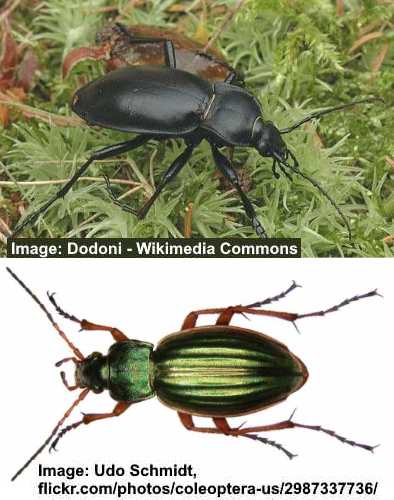
Top picture: Carabus glabratus. Bottom: Carabus auratus (the golden ground beetle)
Carabus is a diverse genus of ground beetles with many species of these large colorful insects common in North America. The carabid beetles are known for their slender oval bodies, vivid metallic coloration, and large size. The beetles grow 0.47” to 2” (12 – 55 mm) long.
Some species of these ground beetles are an unimpressive dull black color. However, other varieties of Carabus beetles have neon red, metallic blue, and shiny copper bronze colors. Most species are identified by their long, spindly black legs, long antennae, and tiny head in relation to their bodies.
Stenolophus Ground Beetles (Stenolophus spp.)
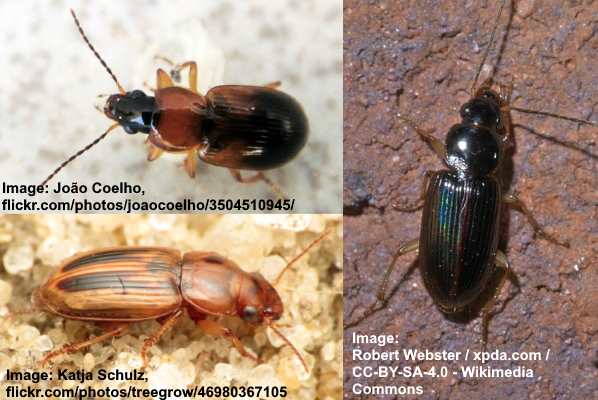
Stenolophus ground beetles. Clockwise from top left: Stenolophus tentonus, Stenolophus ochropezus and Stenolophus lineola
Stenolophus is a large genus of ground beetle commonly found in North America. Beetles in the genus are typically characterized by their slender oval bodies, short antennae, and black and brown bodies.
Common carabid species from the genus Stenolophus are called seedcorn beetles. These small dark brown to black ground beetles measure 0.19” to 0.31” (5 to 8 mm). Some are identified by a broad black stripe on their wing covers and shallow longitudinal furrows. The beetles are most active in spring when they attack seed corn and can destroy crops.
Snail Eating Ground Beetles (Scaphinotus spp.)
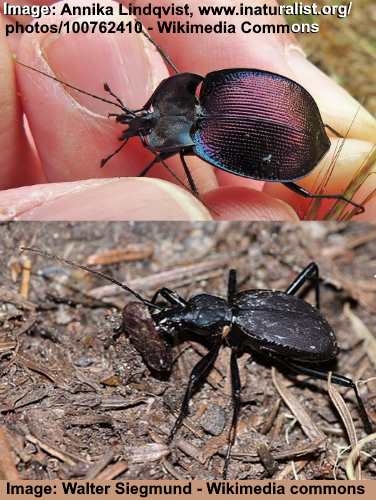
Top image: Scaphinotus elevatus (the eastern snail eater). Bottom: Scaphinotus angusticollis
Ground beetles in the genus Scaphinotus are known for their predatory instincts on snails. The native North American ground beetles generally have a flattened oval body and a long, slender head. The snail-eating beetles are usually a dark brown or black color, and many have iridescent patterns and punctuations on their wing covers.
Snail-eating ground beetles typically measure around 1” (25 mm) long. Color variations include bright metallic green, dark iridescent purple, or matted black.
One of the most common species of beetles in the genus Scaphinotus is the eastern snail eater (Scaphinotus elevatus). The native ground beetle has rounded elytra with purple or violet iridescent patterns. The flightless beetle typically resides in damp environments where snails are common, and they can be active from late spring until late summer.
Ground Beetle Control: How to Get Rid of Ground Beetles
The best way to control ground beetles is to prevent them from entering your home. This requires sealing and repairing potential entry points. Therefore, you should caulk cracks in foundations, window frames at ground level, or spaces around doors. In addition, ensure that you stack firewood away from the house and keep the perimeter free from weeds and garden debris.
Ground beetles rarely become an invasive house pest. However, suppose some find their way indoors. In that case, you can remove them physically with a vacuum or by capturing them in a container. You could also place sticky traps along baseboards to trap the annoying black ground beetles.
Related articles:
